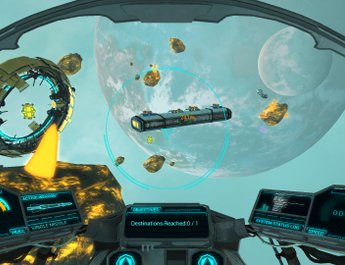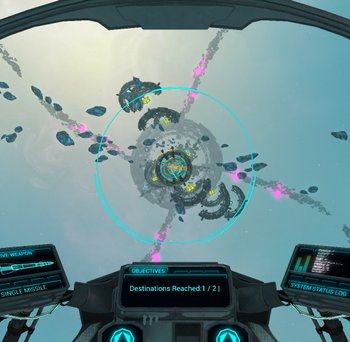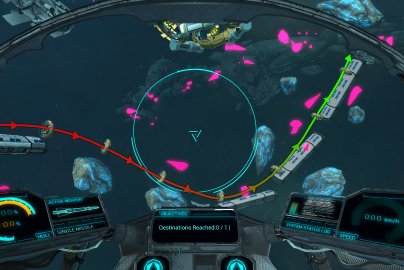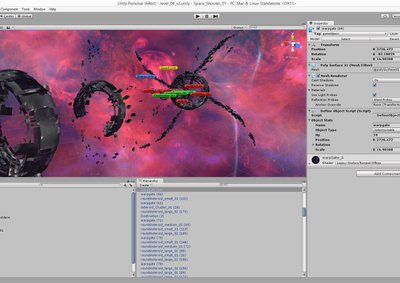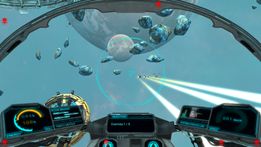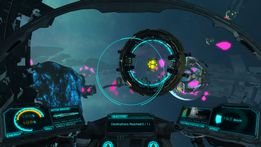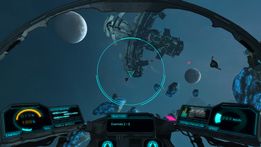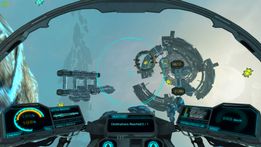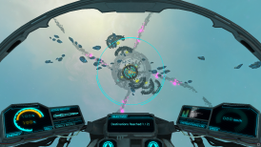Interceptor
Interceptor is a spaceshooter where Sam the underpaid delivery agent, gets caught up in the greatest treasure hunt this galaxy has ever seen. Sam sets out together with his companion
Edward Jones in search for the greatest treasure ever known while fighting off bandits, exploring the deepest parts of space and dashing through warp gates at max speed!
Specification:
- Group: 3x3
- School project: 10 weeks(50%)
- Level editor: Unity
- Engine: In-house
- Team size: 9
- 3 Level Designers
- 3 Artists
- 3 Programmers
My contributions:
- Level design
- Game design
- Mission design
- Set dressing
- Balancing
- TRUM-master
- Sound design
- Bug finder
Tools:
- In-house engine
- In-house tools
- Adobe Photoshop
- Wwise
- Unity as level editor
The gameplay
In Interceptor you control a space ship using both the keyboard and mouse to navigate through space.
Ther core elements of the game is to traverse the galaxy, defeat the enemies your encounter and drive through warp gates to gain a temporary speed, damage or energy boost.
One of the reasons we decided to go with these temporary pick-ups was because we needed a way to guide the player in a game where he can move in any possible direction.
It took some time to get the hang of designing levels for gameplay in space where the player can move in any axis. But I learned a lot about how to use focal points effectively, how to lure players in with colors and interesting shapes and also how to trigger the players sense of exploration.
Energy is really what combat is all about since it is used as a resource to either reduce incoming damage or to fire the ships secondary weapons.
We used this as our core-mechanic in Interceptor and revieced very positive feedback from playtesters who enjoyed being able to choose which way to play the game.
The decision to use warpgates was based on the need of a way to guide a player who is able to go in literally any direction. It also helped make some of the more slow paced parts of the game feel more exciting and gave the player something to do while listening to the games two protagonists telling the player more about the upcoming areas.
It was a really useful tool to design levels around as players ejoyed navigating through rings placed along a curved path, picking up speed boosts as they went.
Design and pipeline
Designing levels for a game that takes place in space was very different from any other project I've worked on. It was very difficult to communicate the 3D space using the traditional way of creating a top-down. Instead I made a very rough prototype in Unity, which we used as level editor. I then exported it to our game engine to try moving between the gameplay areas and get a feel for how the level would work.
When I was happy with the layout I worked on making the environment feel more belivable by creating distant asteroid belts, etc. Adding enemies, triggers and pickups was also done at this point.
The level was then revised over and over untill the gameplay was solid.
In the level I made there was multiple objectives for the player to complete before finishing the entire level. In order to guide the player to the next objective we used on-screen trackers that showed which way to turn and the distance left to get there.
I used this to my advantage so that when the player had completed an objective and turned around to face the direction of next objective, the player could always see the start of a path that heading the direction the player was going. The paths lead all the way to the next objective and went through multiple warp gates with speed boosts in them, making for fun gameplay while moving to the next part of the map.
Screenshots

